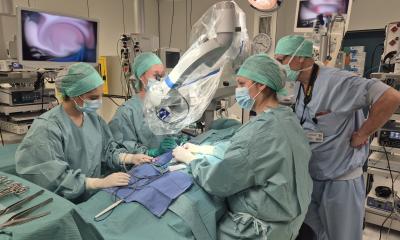Revolutionary approach to heart failure
British girl Hannah Clark who was given an extra heart as a toddler has become the world's first heart transplant patient to make a full recovery after having her donor organ removed and function restored to her original heart. The case highlights that in some cases of cardiomyopathy, it is possible for the patient's own heart to make a full recovery if it is given adequate support to do so.

Heart transplantation is a life-saving procedure in infants and small children with heart failure due to cardiomyopathy. This condition occurs in 1.2—1.4 children per 100,000, and is 8—12 times more common in the first year of life than the subsequent years. The prognosis is very poor. However, it is theoretically possible for the patient’s own heart to recover if they live long enough for this to occur.
Hannah was brought to Harefield Hospital, UK (now part of the Royal Brompton & Harefield NHS Foundation Trust), in 1994. She had symptoms of severe heart failure secondary to cardiomyopathy. At age 2 years (in 1995) Hannah underwent a heart transplant, in which the donor heart was grafted onto, and took over much of the function of, her own heart. The new heart was inserted in parallel to the Hannah’s heart. This allowed long term, almost complete unloading of the left side of Hannah’s own heart, which meant it could gradually recover.
However, as with all transplants of donor organs, the recipient’s immune system must be suppressed using drugs to prevent rejection of the donated organ. Immunosuppression causes a very large increase in the incidence of malignant (cancerous) disease, particularly a type of cancer called Epstein-Barr-virus-associated post-transplant lymphoproliferative disorder (EBV PTLD). EBV is the virus which causes glandular fever in healthy individuals.
Some 4.5 years after the transplant, both the donor heart and Hannah’s own heart were functioning normally. However at this stage, removal of the donor heart—a major operation—was not deemed necessary. However, Hannah continued to have episodes of EBV PTLD, which by age 8 years had begun to spread and become extremely serious. Chemotherapy and multiple courses of drugs were used to get this EBV PTLD into complete remission. However, in January 2003, she developed symptoms suggesting that PTLD had recurred, and she went through similar drug cycles to treat it. This continued for two further years. Then, in 2005, an echocardiogram showed that while her own heart remained functioning normally, the function of the donor heart had become impaired. This was because doctors had needed to reduce Hannah’s immunosuppressant drugs to help her fight PTLD, leading to symptoms of rejection of the donor heart. And, since her PTLD was seemingly incurable while even partly immunosuppressed, the doctors decided to remove the donor heart so that immunosuppression could be stopped altogether. This had never been done before.
Surgery to remove the donor heart took place at Great Ormond Street Hospital, London, UK, in February, 2006, just over a decade after the original operation. The surgery team was led by consultant Victor Tsang and Professor Sir Magdi Yacoub. Following surgery, the immunosuppressant drugs were removed altogether, and Hannah has since made a complete recovery from the EBV PTLD.
Professor Yacoub says: “Hannah’s case has provided many lessons relevant to biology, transplantation, heart recovery and malignant disease. We all hope that this will stimulate further research and progress in this area.”
Mr Tsang adds: “"Hannah's case highlights that, in cases of infant cardiomyopathy such as hers, it is possible for the patient's own heart to make a full recovery if it is given adequate support to do so. This is an important piece of knowledge as we are now gaining more experience with mechanical support for the failing heart in children."
Details of Clark's revolutionary transplant and follow-up were published online Tuesday, July 14, 2009 in the medical journal, Lancet.
21.07.2009







